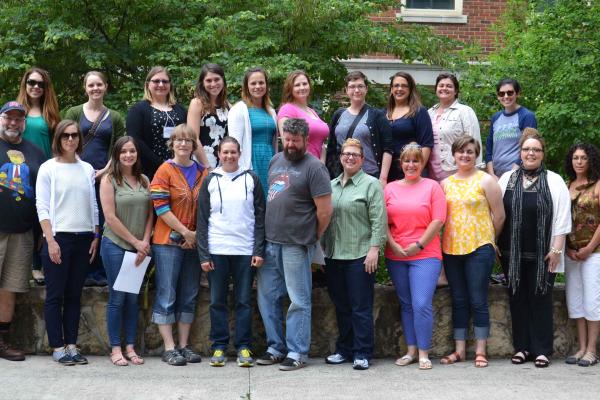Global Teacher Seminar helps Ohio teachers integrate human rights into the classroom

The Center for Slavic and East European Studies hosted the second Global Teacher Seminar: “Human Rights in a Global Perspective: Mass Atrocities and State-Sponsored Violence” from June 5-9, 2017, in partnership with the Department of Teaching and Learning and co-sponsored by the Center for African Studies, Center for Latin American Studies, East Asian Studies Center and the Middle East Studies Center. Each Center sponsored one area-specific case study that examined mass atrocity and state-sponsored violence. Through this collaboration, the institute gave teachers the opportunity to learn from a pedagogy expert as well as area studies specialists.
Over 20 middle and high school teachers from across Ohio attended the weeklong institute on The Ohio State University’s campus with the goal of deepening their knowledge on international human rights and finding new content to incorporate into their curricula. CSEES partnered with Tami Augustine (Department of Teaching and Learning, Ohio State) who provided pedagogy expertise to assist the teachers in developing methods for making human rights content approachable and engaging for students.
Jenny Suchland (Department of Slavic and East European Languages and Cultures, Department of Women’s, Gender and Sexuality Studies, Ohio State) was a lead facilitator of the institute and gave three presentations on different aspects of human rights’ protections. She started with an interactive activity that engaged the teachers in a brainstorming exercise where they recorded ideas on “what makes us human?” and “what about being a human should be considered a right?” Suchland also introduced critical perspectives on human rights, which demonstrated to the teachers that since their inception, there have been significant shortcomings in human rights’ protection, which has prompted subsequent movements that have fought for rights for minority groups.
After introducing a framework for human rights analysis, four presenters discussed different case studies of mass atrocity and state-sponsored violence. For the Eastern European and Middle East content, Khatchig Mouradian (Columbia University) gave the first case study, which focused on the legal history of the crime of genocide with a particular emphasis on Armenia. Through this presentation, he provided an excellent framework for how to study and teach about mass atrocity, arguing that the narrative should give a voice to the victims and survivors rather than telling the story of the aggressors. He also asserted that perpetrators of mass atrocities and genocide are normal people, but become motivated to commit these crimes due to their need to find a “solution” to a “problem”. Mouradian gave the teachers a lens to examine the subsequent situations of mass atrocity covered in the institute.
Mitch Lerner (Department of History, Ohio State) presented on the East Asian case study which examined state repression and prison camps in North Korea. His presentation traced the fascinating, yet brutal history of North Korea and gave insight into how the Kim family has maintained absolute power for over 60 years. To illustrate just how repressive the Kim regime is, Lerner screened the documentary Camp 14: Total Control Zone, whose main character had escaped from a North Korean work camp and traveled the world, detailing what life in North Korea is like.
Jibril Mohamed (Department of African American and African Studies, Ohio State) covered the African case study with a presentation on the history of Somalia and the Somali diaspora. He focused on the legacy of colonialism in Somalia, Siad Barre’s rule and the 1991 collapse of the country and ensuing civil war. He also discussed the Somali diaspora and Somali immigrants in Ohio. He informed the teachers about different aspects of Somali culture that differs from American cultural norms. Following Mohamed’s lecture, Angie Plummer, the Executive Director of Community Refugee and Immigration Services (CRIS) discussed refugee resettlement in Columbus, focusing on how refugees reach our community and what challenges they face upon arrival.
The final case study was on the Colombian Civil War and the FARC Peace Agreement. Laura Fernandez (Assistant Dean of Graduate and International Students, Moritz College of Law, Ohio State) framed the conflict and peace agreement within the transitional justice framework. Transitional justice promotes reconciliation during and after violence through judicial and non-judicial means and seeks to address the needs of victims. Fernandez also led the teachers through a dispute-resolution exercise that can be used in their classrooms to solve conflicts and promote effective communication.
The institute also covered human trafficking, both at the local and global level. Suchland discussed international human trafficking and modern-day slavery, followed by Sophia Papadimos from the Ohio Human Trafficking Task Force who led a working lunch that informed the teachers on state initiatives that seek to support victims of human trafficking and influence legislators to enact laws that provide more protections against sex and labor trafficking.
By the end of the week, the teachers had drafted an outline of a lesson plan that they presented on Friday afternoon. They will work over the summer to create a finalized version of the plan that they will implement in the 2017-2018 school year. With the help of an Ohio Humanities “Educator Enrichment Grant” CSEES outreach coordinator, Kathryn Metz, will provide six months of follow-up consultations with the teachers, sending them additional resources, providing lesson plan review and visiting their classrooms to help teach about human rights. Photos from the institute can be found on the Global Teacher Seminar's homepage.
Participants reported that the institute increased their understanding of human rights and situations of mass atrocity and their increased knowledge helped them grow as teachers and will allow them to teach these subjects with more clarity and accuracy.
In addition to the Ohio Humanities grant, the institute was made possible Title VI funding from the U.S. Department of Education’s International and Foreign Language Education Division.
